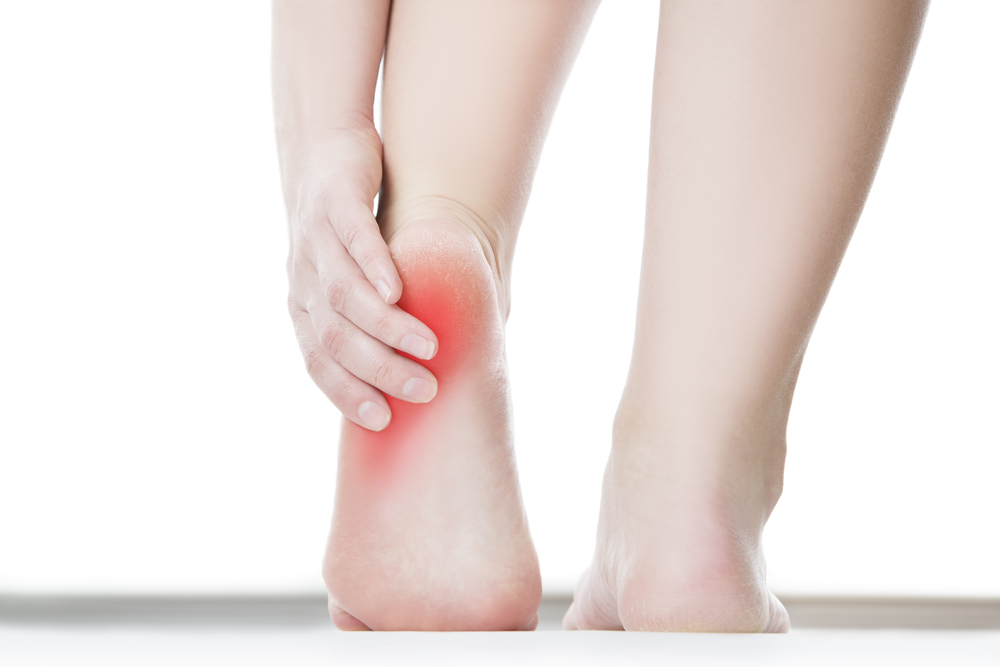Pain in the heel can be debilitating and prevent patients from taking part in their regular activities. There are many reasons why someone might suffer from heel pain. They could have an inflammation, cracked skin, or even a stress fracture. The fastest way to get rid of painful symptoms is to contact a foot doctor in Kelowna, BC or Victoria, BC and get the condition diagnosed.
What Is the Fastest Way to Cure Heel Pain?
Many conditions that lead to foot pain can be treated at home. You might need to ice and elevate your foot and switch to low-impact exercises like swimming or cycling for one to three months. If your pain doesn’t get better within two weeks, book an appointment with a foot specialist. They will perform imaging studies to find out why you’re in pain and evaluate whether you need physical therapy, a steroid injection, or surgery.
Cracked Heels
As we grow older, our bodies produce less of the structural protein elastin, so our tissues become less elastic and supple. This leads to dry skin and cracks in the heels. Although the condition itself isn’t dangerous, it can result in painful symptoms and infections, since pathogens can enter the body more easily through the cracks.
If you’re in pain due to cracked or dry skin, apply a strong moisturizer before going to bed and wear thin cotton socks during the night. Soak your feet in warm water, then use a pumice stone to get rid of the dead skin. Large cracks can be covered up with liquid bandages until they heal. Remember to always keep your feet clean because this reduces your risk of infection.
Achilles Tendinitis
Achilles tendinitis is a painful inflammation of the Achilles tendon. It often happens to athletes who rapidly increase their exercise levels. The most common symptom is pain in the leg and above the heel that gets worse after running, jumping, or walking up the stairs. Sometimes, patients also suffer from stiffness in the morning.
The best way to treat tendinitis is to rest your legs and avoid high-impact exercise for a while. You can take over-the-counter pain medication, ice your leg, and use a soft brace or bandage to protect the tissues. If you developed Achilles tendinitis due to a postural problem or muscle weakness, work with a physical therapist. They will show you stretching and strengthening exercises that take pressure off your tendon and prevent future problems.
Bursitis
Bursae are small, fluid-filled sacs that absorb shock and lubricate the joints. The bursa between your Achilles tendon and your heel bone can get inflamed if you overuse your legs and ankles without building up the muscles first. Bursitis also happens to people who suffer from arthritis, gout, or a foot deformity. The main symptoms are pain, warmth, and swelling behind the heel, but you might also notice discoloration and tenderness when standing on your toes.
Like Achilles tendinitis, bursitis responds well to home remedies like icing, elevating, and resting your foot. Sometimes, a corticosteroid injection or surgery is necessary, but only if holistic measures aren’t working. If you’ve developed bursitis due to a postural problem, you might benefit from wearing heel wedges that encourage you to walk correctly.
Arthritis
Sometimes, pain in the heel that doesn’t go away after a few weeks is caused by arthritis. This condition develops due to natural wear and tear, inflammatory conditions, or autoimmune diseases. It affects almost one-quarter of the adult population. People who are overweight, play high-impact sports, or have a family history of joint disease are more likely to develop arthritis in the feet and ankles.
Common symptoms are stiffness in the morning, pain, limited movement, swelling, redness, and heat. Most doctors recommend that patients do low-impact exercise and physical therapy to strengthen the tissues around the arthritic joint and reduce the pain. Topical and internal pain medication can also help. Sometimes, surgery is necessary.
A Stress Fracture
A calcaneal stress fracture is most common in athletes who put a lot of pressure on their bodies, but it can also happen to people who suffer from osteoporosis, frequently consume substances like tobacco or alcohol, or have an eating disorder. The pain associated with this condition only affects one part of the heel, and it increases when the patient stands for a long time or tries to stretch their foot.
The best way to recover from a calcaneal stress fracture is to rest, ice, and elevate your foot for several weeks. Your Kelowna, BC or Victoria, BC foot doctor might ask you to wear a splint or boot to keep the injured tissues safe and prevent excessive movement. It’s unlikely that you’ll need surgery because most stress fractures heal on their own.
Plantar Fasciitis
Plantar fasciitis is an inflammation of the fascia at the bottom of the foot. It is common in people who exercise on hard surfaces, overstretch the sole of their feet, are very overweight, or wear poor shoes when they exercise. It can also affect those who do a lot of high-impact exercise without stretching their calves. Plantar fasciitis leads to difficulty raising the toes off the ground and heel pain that gets worse after sleeping and resting.
Fortunately, this condition is relatively easy to treat at home. Rest and ice your feet, wear supportive and cushioned shoes, gently stretch your calves every day, and take over-the-counter painkillers when necessary. Your symptoms should improve within two weeks. If not, you might need custom-made insoles or physio exercises that help you to improve your posture and strengthen the muscles in the legs and feet.
How to Prevent Pain in the Heel
There’s a lot you can do to keep your feet healthy and prevent painful symptoms. Start by optimizing your foot care routine. Wash your feet every day, and apply moisturizer to the heels if they are prone to cracking. Keep your feet as dry as possible to prevent fungal and bacterial infections. Wear supportive shoes with broad soles.
Stress fractures, tendinitis, bursitis, and plantar fasciitis often occur after people start a new exercise routine. When you begin practising a new sport, go slowly to give your body time to adjust to the new activity. Lead a lifestyle that allows you to maintain a normal weight and therefore reduce the pressure placed on your feet. Healthy habits include eating nutritious foods, avoiding high-calorie beverages and snacks, exercising regularly, and reducing stress.
Do I Need to See a Foot Doctor in Kelowna, BC or Victoria, BC?
If you’ve had foot pain for more than two weeks, you need to see a specialist. Don’t wait too long because some conditions get worse when they aren’t treated properly.
The doctor will examine your foot, ask you about your symptoms, and do imaging studies to diagnose your condition. Then, they’ll show you how you can get rid of your painful symptoms. Surgery isn’t typically necessary unless you have severe, recurring pain that prevents you from moving around freely.
Heel pain is a common problem. Some of the causes include cracked heels, Achilles tendinitis, bursitis, arthritis, a stress fracture, and plantar fasciitis. The best treatment method depends on the reason why you have pain in the heel. Get in touch with us at Island Foot Clinics in Kelowna, BC and Victoria, BC to book an appointment with a foot doctor.

